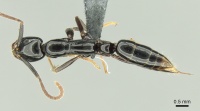Leptogenys lucida
| Leptogenys lucida | |
|---|---|

| |
| Scientific classification | |
| Kingdom: | Animalia |
| Phylum: | Arthropoda |
| Class: | Insecta |
| Order: | Hymenoptera |
| Family: | Formicidae |
| Subfamily: | Ponerinae |
| Tribe: | Ponerini |
| Genus: | Leptogenys |
| Species group: | attenuata |
| Species: | L. lucida |
| Binomial name | |
| Leptogenys lucida Rakotonirina & Fisher, 2014 | |
Workers have been found foraging on the ground and low vegetation, while their nests are most often located in rotten logs and soil layers.
Identification
A member of the attenuata species group. Rakotonirina and Fisher (2014) - Worker. Length of third antennal segment less than twice of length of second segment; in full-face view, eye not breaking outline of side of head; mesopleural sulcus broad and shallow, transversely sculptured, oriented to level of posteroventral corner of pronotum; legs brown and light brown towards apical portion.
Leptogenys lucida appears very similar to Leptogenys malama, but the smaller-sized body, the orientation of the mesopleural suture to the level of posteroventral angle of the pronotum in lateral view and the generally lighter color of the entire portion of the legs relative to the overall color of the body can separate it from the latter, which possesses larger body size and a mesopleural suture oriented to the level of posterodorsal angle of the pronotum.
Keys including this Species
Distribution
The distribution of L. lucida includes the montane rainforest of the PN Mantadia- Andasibe and the rainforest of the PN Zahamena in central-eastern Madagascar. It also occurs in lowland rainforests of the PN Mananara-Nord, RS Ambatovaky and RNI Betampona.
Latitudinal Distribution Pattern
Latitudinal Range: -18.75737° to -18.75737°.
| North Temperate |
North Subtropical |
Tropical | South Subtropical |
South Temperate |
- Source: AntMaps
Distribution based on Regional Taxon Lists
Malagasy Region: Madagascar (type locality).
Distribution based on AntMaps
Distribution based on AntWeb specimens
Check data from AntWeb
Countries Occupied
| Number of countries occupied by this species based on AntWiki Regional Taxon Lists. In general, fewer countries occupied indicates a narrower range, while more countries indicates a more widespread species. |

|
Estimated Abundance
| Relative abundance based on number of AntMaps records per species (this species within the purple bar). Fewer records (to the left) indicates a less abundant/encountered species while more records (to the right) indicates more abundant/encountered species. |

|
Biology
|
Castes
Nomenclature
The following information is derived from Barry Bolton's Online Catalogue of the Ants of the World.
- lucida. Leptogenys lucida Rakotonirina & Fisher, 2014: 53, figs. 25B, 67, 80 (w.q.) MADAGASCAR.
Unless otherwise noted the text for the remainder of this section is reported from the publication that includes the original description.
Description
Worker
(8 specimens). HW: 0.96–1.07, HL: 1.32–1.43, CI: 72–77, SL: 1.20–1.39, SI: 122–135, PW: 0.75–0.84, WL: 2.09–2.25, PNH: 0.57–0.66, PNL: 0.57–0.66, PNW: 0.43–0.53, DNI: 73–86, LNI: 94–108.
Head longer than broad; lateral margin slightly convex and rounding to nearly straight posterior margin. In full-face view, eye medium-sized, maximum diameter about one-fourth to one-fifth of length of lateral cephalic border; not extending beyond line of lateral border of head. Antennal scape relatively long, surpassing posterior cephalic margin by one third its length. Third antennal segment normal, less than twice the length of the second. Widest portion of inner margin of mandible rounded, without blunt angle or preapical tooth. In profile, mesopleural sulcus a broad, shallow and parallel dashed line running toward level of posteroventral corner of pronotum. Propodeal lobe toothlike, blunt. In dorsal view, petiolar node longer than broad, width decreasing anteriorly; in lateral view, node about as long as high; anterior margin straight, shallow transversal impression rarely distinct at junction between anterior and dorsal margin; dorsal margin forming a distinct angle with straight posterior margin. Mandible smooth and shining between sparse, small punctures. Head, clypeus, mesosoma, declivitous surface, petiolar node and gaster generally smooth and shining; scattered small punctures present on head dorsum. Posterior portion of pronotal dorsum, petiolar node and first two gastral tergites usually lacking standing hairs and pubescence; dorsum of propodeum may have short suberect hairs. Body color and dark brown to brown, appendages brown and slightly lighter toward the apices.
Queen
(1 specimen): HW: 1.07, HL: 1.50, CI: 72, SL: 1.37, SI: 127, PW: 0.83, WL: 2.10, PNH: 0.65, PNL: 0.46, PNW: 0.59, DNI: 128, LNI: 142. From PN Zahamena. Closely resembles worker in overall body shape except that the ergatoid queen possesses a much broader head, shorter but wider petiolar node, enlarged gastral segments and incompletely developed thoracic sclerites. FIGURE 67. Leptogenys lucida holotype worker CASENT0294372. A: lateral view. B: head in full-face view. C: dorsal view.
Type Material
Holotype worker: Madagascar, Toamasina, Corridor Forestier Analamay-Mantadia, Tsaravoniana, -18.75737, 48.42302 ± 100m, 1018 m, rainforest, ex rotten log, 08–09 Nov 2012 (B.L. Fisher et al.) collection code: BLF30246 specimen code: CASENT0294372 (California Academy of Sciences).
References
- Rakotonirina, J.C. & Fisher, B.L. 2014. Revision of the Malagasy ponerine ants of the genus Leptogenys Roger (Hymenoptera: Formicidae). Zootaxa 3836, 1-163.
References based on Global Ant Biodiversity Informatics
- Rakotonirina J. C., and B. L. Fisher. 2014. Revision of the Malagasy ponerine ants of the genus Leptogenys Roger (Hymenoptera: Formicidae). Zootaxa 3836 (1): 001163.

